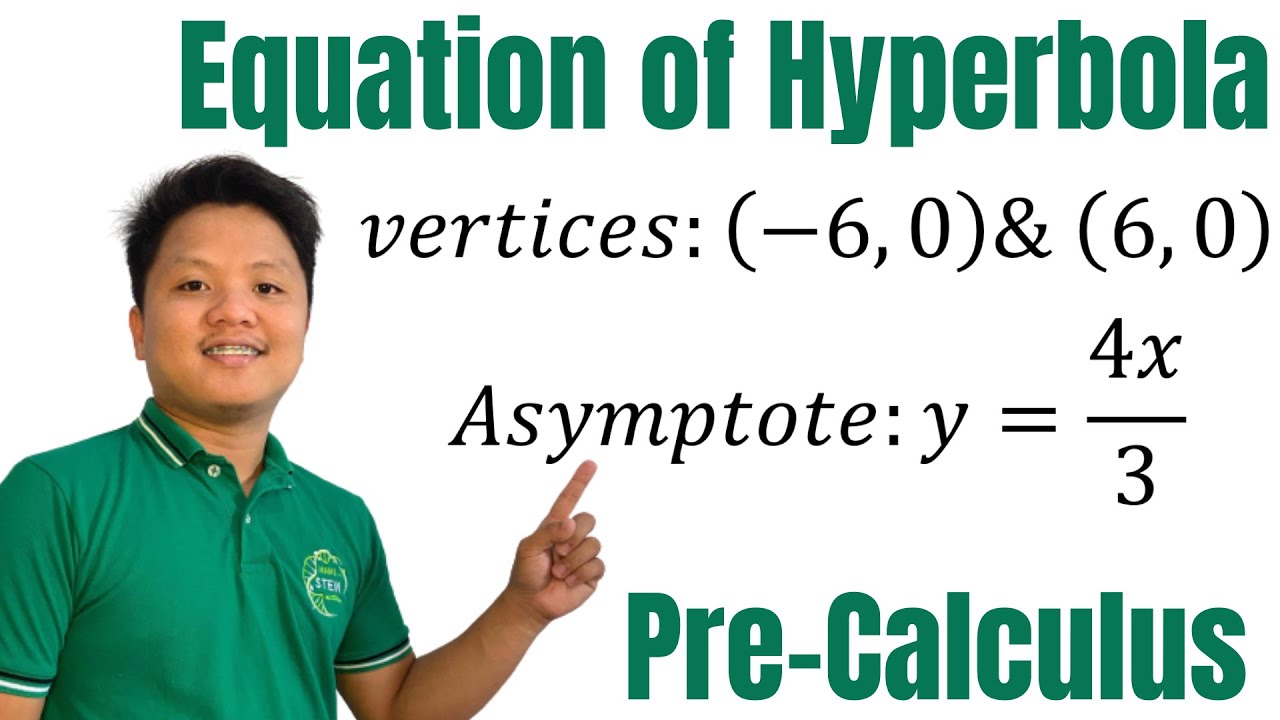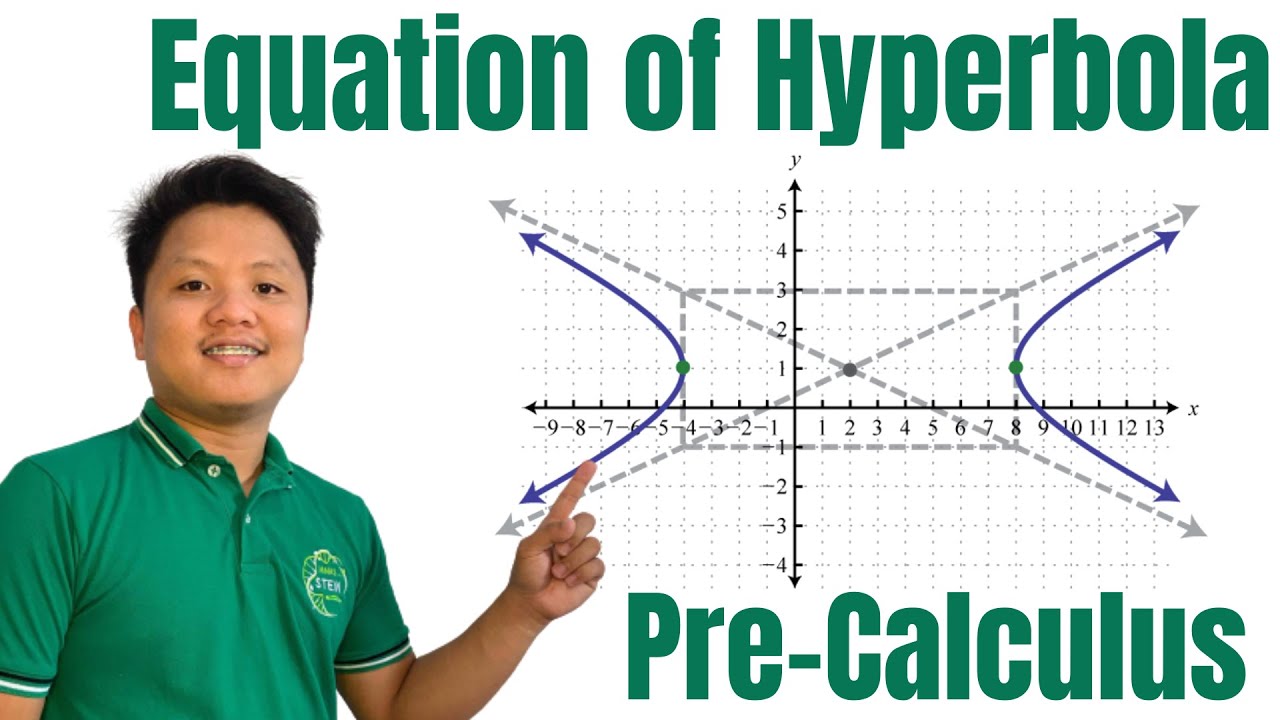How to find the equation of Hyperbola given vertex, and the equation of asymptote
TLDRIn this educational video, Prof D demonstrates how to derive the equation of a hyperbola when given its vertices and the equation of its asymptote. The example provided has vertices at (-4, 2) and (2, 12), with an asymptote equation y = -2x + 8. The video explains that since the vertices form a vertical line, the hyperbola opens vertically. Using the distance formula and the slope of the asymptote, the video calculates the values of 'a' and 'b', and then constructs the standard form of the hyperbola's equation. The final equation is simplified and presented, offering viewers a clear understanding of the process.
Takeaways
- 📚 The video is a tutorial on finding the equation of a hyperbola given its vertices and the equation of its asymptote.
- 📍 The example provided has vertices at (-4, 2) and (12, 2), indicating the hyperbola opens vertically.
- 📐 The center of the hyperbola is calculated to be at (2, 4), which is the midpoint between the vertices.
- 🔍 The value of 'a' is determined to be 8 units, which is the distance from the center to a vertex.
- 📈 The slope of the asymptote is given as -2, which is used to find the value of 'b'.
- 🧩 The value of 'b' is calculated to be -4 by using the slope of the asymptote and cross-multiplication.
- 📝 The standard form of the hyperbola's equation is derived as (y - k)^2 / a^2 - (x - h)^2 / b^2 = 1.
- 🔢 The final equation of the hyperbola is simplified to (y - 4)^2 / 64 - (x - 2)^2 / 16 = 1.
- 👨🏫 The presenter is Prof D, who encourages viewers to ask questions or seek clarifications in the comments.
- 👋 The video concludes with a sign-off from Prof D, indicating the end of the tutorial.
Q & A
What is the main topic of the video?
-The main topic of the video is to demonstrate how to find the equation of a hyperbola given its vertices and the equation of its asymptote.
What are the coordinates of the vertices given in the example?
-The coordinates of the vertices given in the example are (-4, 2) and (12, 2).
What does the orientation of the vertices indicate about the hyperbola?
-The orientation of the vertices indicates that the hyperbola has a vertical transverse axis, meaning its opening is vertical.
What is the general form of the equation for a hyperbola with a vertical transverse axis?
-The general form of the equation for a hyperbola with a vertical transverse axis is \((y - k)^2 / a^2 - (x - h)^2 / b^2 = 1\).
What is the center of the hyperbola in the given example?
-The center of the hyperbola in the given example is (2, 4), which is calculated by averaging the x-coordinates and y-coordinates of the vertices.
What is the value of 'a' in the hyperbola equation, and what does it represent?
-The value of 'a' in the hyperbola equation is 8. It represents the distance between the center of the hyperbola and each vertex along the transverse axis.
What is the equation of the asymptote given in the example, and what does it tell us about the hyperbola?
-The equation of the asymptote given in the example is \(y = -2x + 8\). It tells us the slope of the asymptotes and helps in determining the value of 'b' in the hyperbola equation.
How is the value of 'b' in the hyperbola equation determined?
-The value of 'b' is determined by using the slope of the asymptote and the relationship between 'a' and 'b'. In this case, it is found by solving the equation \(-2b = 8\), which gives \(b = -4\).
What is the final equation of the hyperbola in the given example?
-The final equation of the hyperbola in the given example is \((y - 4)^2 / 64 - (x - 2)^2 / 16 = 1\).
What does the video suggest if you have questions or need clarifications?
-The video suggests that if you have questions or need clarifications, you should leave them in the comment section below.
Who is the presenter of the video?
-The presenter of the video is Prof D.
Outlines
📚 Welcome and Introduction to Hyperbolas
In this segment, the instructor welcomes the class back to the channel and introduces the topic of finding the equation of a hyperbola given its vertices and asymptote. The example provided includes vertices at (2, -4) and (2, 12), and the asymptote equation y = -2x + 8. The first steps involve identifying the vertices and recognizing the vertical alignment, which determines that the hyperbola's transverse axis and opening are vertical.
🧮 Calculating Hyperbola Parameters
This section focuses on determining the parameters needed for the hyperbola's equation. The center of the hyperbola is calculated as the midpoint between the vertices, yielding (2, 4). The value of 'a' is identified as the distance from the center to a vertex, which is 8 units. The slope of the asymptote (-2) is used to find the value of 'b' through cross-multiplication, resulting in b = 4. These values are then used to construct the standard form of the hyperbola's equation.
✍️ Finalizing the Hyperbola Equation
The final part of the video simplifies the standard form of the hyperbola's equation using the calculated parameters. The equation y - 4^2 / 64 - (x - 2)^2 / 16 = 1 is derived. The instructor concludes the lesson by encouraging viewers to leave any questions or clarifications in the comments, signing off with a thank you and a promise to see them in the next video.
Mindmap
Keywords
💡Hyperbola
💡Vertices
💡Asymptote
💡Center
💡Transverse axis
💡Equation
💡Standard form
💡A
💡B
💡Slope
Highlights
Introduction to finding the equation of a hyperbola given its vertices and the equation of its asymptote.
Vertices are given as (-4, 2) and (12, 2) indicating the hyperbola opens vertically.
The center of the hyperbola is calculated to be at (4, 4).
The value of 'a' is determined to be 8 units, the distance between the vertex and the center.
The equation of the asymptote is given as y = -2x + 8.
The slope of the asymptote is -2, which is derived from the given equation.
The value of 'b' is calculated using the slope and the center's coordinates.
The equation for 'b' is solved using cross multiplication, resulting in b = -4.
The standard form of the hyperbola equation is introduced.
The equation is simplified into y - 4^2 / 64 - (x - 2)^2 / (-4)^2 = 1.
The final equation of the hyperbola is presented in a simplified form.
An invitation for questions or clarifications is extended to the viewers.
The video concludes with a sign-off from Prof D.
The importance of understanding the hyperbola's orientation based on its vertices is emphasized.
The method of finding the center of the hyperbola using the vertices is explained.
The process of determining the value of 'a' and 'b' for the hyperbola's equation is detailed.
The relationship between the slope of the asymptote and the hyperbola's equation is discussed.
The final equation is derived by substituting the values of 'a', 'b', 'h', and 'k' into the standard form.
Transcripts
Browse More Related Video

Find the equation of Hyperbola given vertices and asymptote

How to find the equation of an ellipse given foci and vertices | @ProfD

Learn How to Graph a Hyperbola | Graphing Hyperbola with Center at the Origin

How to find the equation of Hyperbola given its graph

How to find the equation of a parabola given vertex and directrix | @ProfD

Find the equation of an ellipse given center, and the length of major and minor axes | @ProfD
5.0 / 5 (0 votes)
Thanks for rating: